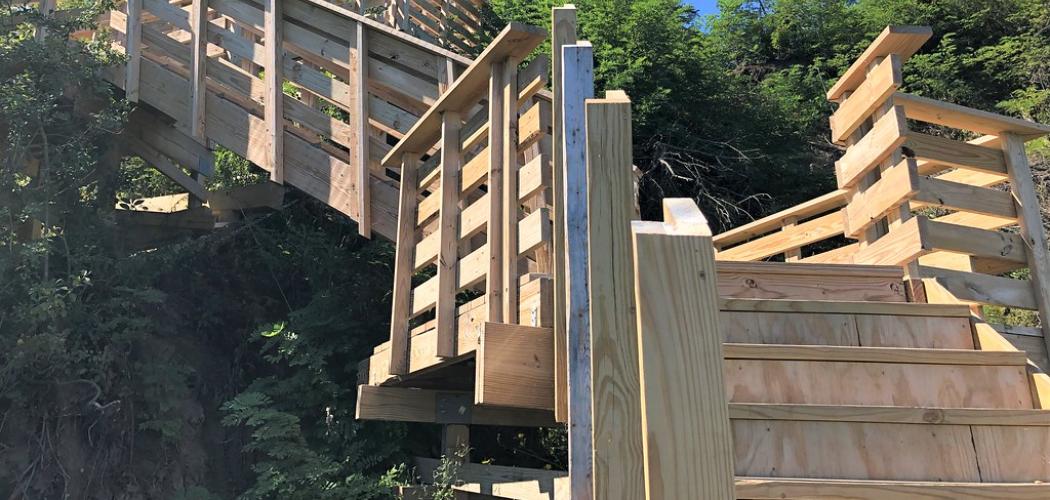Are you planning to make your steep slope more accessible and manageable for foot traffic? Whether you’re remodeling your property or just looking for a challenging DIY project, building stairs on a steep slope isn’t something to be taken lightly. Not only do they have to be functional, but they also must meet certain building and safety codes -no small feat!
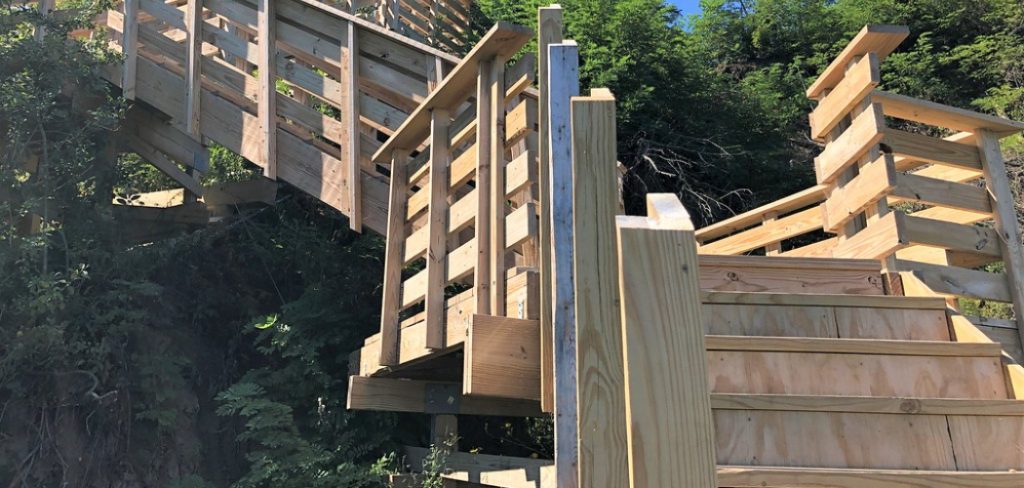
While its location may seem like an obstacle, it is possible to build wooden stairs on a steep slope. It requires careful planning, a lot of effort, and attention to detail, but the end result can greatly improve the usability and safety of your property.
But with the right materials, tools, and information, you can accomplish this task with patience and careful planning. In this post, we’ll break down how to build wooden stairs on a steep slope step-by-step so that you can get up or down safely without risking injury to yourself or anyone else.
The Benefits of Building Wooden Stairs on a Steep Slope
Building wooden stairs on a steep slope may seem like an ambitious task, but once it’s complete, there are some major benefits that come with it.
1. Add Dimension
Not only do the stairs add character and charm to the landscape, but they also make accessing areas of your yard or property much easier. It will also offer a safe and secure way to get up or down the slope without having to worry about slipping or falling.
2. Increase Value
Installing wooden stairs on a steep slope can also add value to your home or property. By making it more accessible, prospective buyers will be more likely to take an interest in what you have to offer.
3. Save Time and Energy
Having stairs in place can save you a significant amount of time and energy when it comes to getting up or down the slope. Instead of having to find alternate ways, such as crawling on all fours or shimmying up a tree, the stairs will be there to make your life much simpler.
Now that you know the benefits of building steps on a steep slope, let’s take a look at how to do it.
Required Items
- Safety glasses
- Hard hat
- Tape measure
- Level
- Miter saw, or circular saw
- Drill with drill bits and driver bits
- Hammer and nails
- Pressure treated lumber
10 Tips on How to Build Wooden Stairs on a Steep Slope
Step 1: Measurement
Before you begin building your stairs, measure out each step to determine where they will go. Make sure that each step is wide enough for two feet side-by-side. Measure the height of each step and mark it off accordingly.
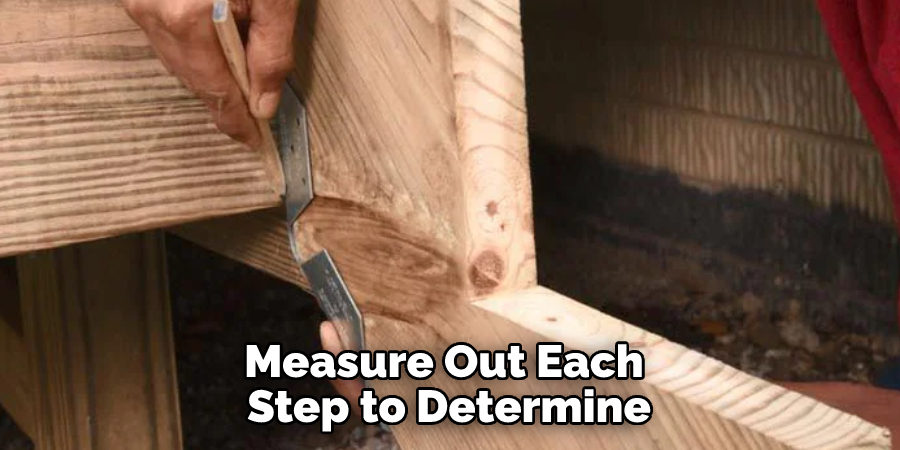
Step 2: Layout
Once you have your measurements down, use a level to map out where each stair will go on the ground. Make sure that each step is even and line up with the other stairs in order to ensure proper installation.
Step 3: Cut the Stringers
Using your miter saw or circular saw, cut two 2×6-inch pressure-treated lumber into stringers. Stringers are the boards that will support each step and need to be cut at a forty-five-degree angle so that they sit securely on the ground.
Step 4: Secure the Stringers
Once the stringers are in place, use a hammer and nails to secure them to the ground on either side of the stairs. Make sure that they are even and tightly secured in order for the steps to fit securely.
Step 5: Cut the Steps
Using your miter saw or circular saw, cut each step out of pressure-treated lumber. Make sure that each step is even and lines up with the stringers. While cutting the steps, make sure to mark off the height of each step on the stringer.
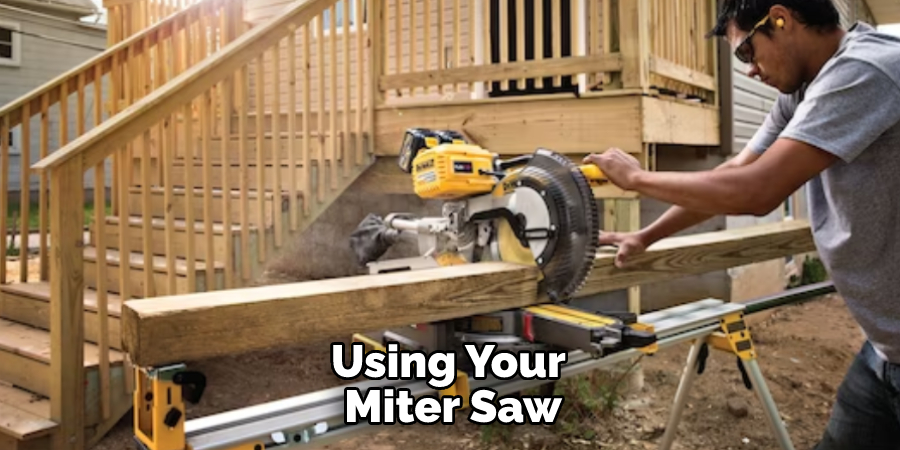
Step 6: Secure the Steps
Once you have cut all of your steps, it’s time to secure them in place. Using a drill and screws, attach each step to the stringers on either side. Make sure that they are secure and even in order to ensure a safe and secure staircase.
Step 7: Finishing Touches
Once all of your steps are secured, it’s time for the finishing touches. Add non-slip strips to each step for added safety, or you can even add a handrail if desired. To complete the look, add some decorative trim around the side of each step to give it a finished look.
Step 8: Clean Up
Once you are done building your stairs, make sure to clean up any debris or sawdust from the area. This will help to keep your staircase looking neat and tidy for years to come. Cleaning up the area also ensures that there is nothing left behind that could potentially be a hazard.

Step 9: Check for Stability
Once your stairs are complete, check to make sure they are stable and safe for use. Walk up and down them several times to make sure that each step is secure and even. If any steps feel loose or unsteady, use a hammer and nails to secure them in place.
Step 10: Enjoy the View
Now that you have your stairs built enjoy the view from the top of your steep slope! You can now safely access this area with ease, making it easier to get around and appreciate all that nature has to offer.
Building wooden stairs on a steep slope may seem like a daunting task, but with the right tools and techniques, it can be done safely and efficiently. With these ten tips in mind, you’ll be able to build your very own sturdy staircase in no time!
8 Safety Precautions to Follow
Building wooden stairs on a steep slope increases safety by providing a secure and stable pathway up or down the incline. With proper construction, these stairs can be made to meet building codes for safety, helping ensure that any pedestrian traffic remains secure and steady. To ensure the best possible safety for the stairs on a steep slope, there are eight main safety precautions to follow:
1. Build with treated wood to prevent rot. Treated lumbers and other building materials should be used in order to ensure that the stairs remain stable and safe over time. Over time, wood can warp or rot due to water accumulation, so treated wood can help prevent any potential accidents.
2. Secure treads and risers with screws, not nails. Using screws instead of nails to attach the treads and risers of the stairs is essential for ensuring that the steps remain secure and stable. Nails tend to loosen over time, but screws are much less likely to come undone.
3. Check for appropriate stair dimensions. The rise and run of the stairs should be within the range allowed by building codes in order for them to be safe for use. Also, the width of each step must have adequate space for a person to stand on without feeling unstable.
4. Make sure stairs are wide enough for two-way traffic. If the stairs are used by more than one person at a time, they should be constructed to allow for two-way traffic. This will help prevent congestion and potential accidents.
5. Apply non-slip material to each tread. Non-slip material helps minimize slippage on the steps. This is especially important on a steep slope, where slipping can be more dangerous due to the larger potential for injury.
6. Use railings and/or handrails. Installing railing along one or both sides of the stairs will help keep pedestrians safe by providing something to hold onto as they ascend or descend the stairs.
7. Cut away tree roots and other obstacles. Tree roots or other obstacles in the soil can cause instability in the stairs and should be avoided if possible. If this is not possible, it may be necessary to cut away the roots or move the obstacle prior to the construction of the stairs.
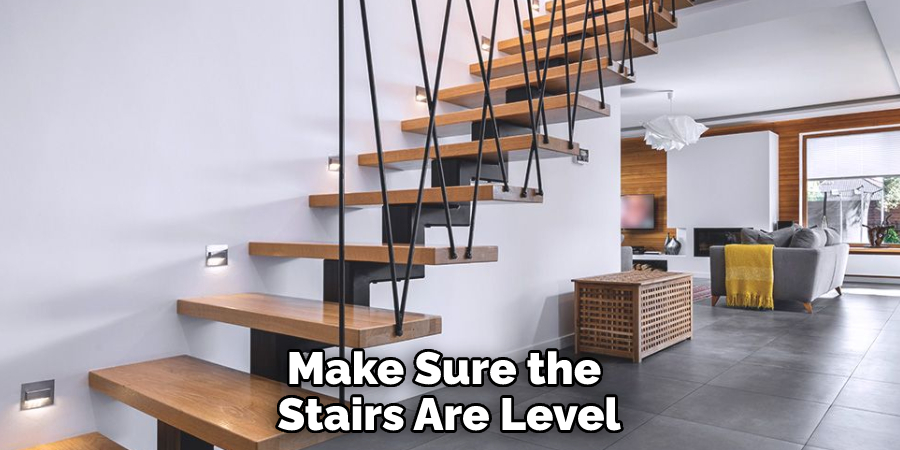
8. Make sure the stairs are level and secure. The stairs should be constructed on a level surface to avoid any potential trips or falls. Additionally, the construction of the stairs should be checked regularly to ensure that it is still secure and properly maintained.
Following these safety precautions will help ensure that wooden stairs built on a steep slope are safe for use by pedestrians. With proper maintenance and frequent inspections, these stairs can provide a secure and stable pathway up or down the incline.
Conclusion
Building wooden stairs on a steep slope is no easy task – from calculating the angle of incline to finding the right materials for the job, it’s not for the faint of heart. However, seeing your new stairs in action can be one of the most rewarding DIY projects out there.
With some ambition and hard work and these methods on how to build wooden stairs on a steep slope, you can create a safe and durable set of stairs. But if taking it on yourself is too aggressive an undertaking, employing a professional carpenter may be the best option available to you.
Not only will they have expertise in building such structures with precision, but they’ll also provide you with peace of mind, given their experience. No matter what route you take, be sure that your wooden stairs on a steep slope are sturdy enough to accommodate foot traffic and any other challenge Mother Nature throws your way!

